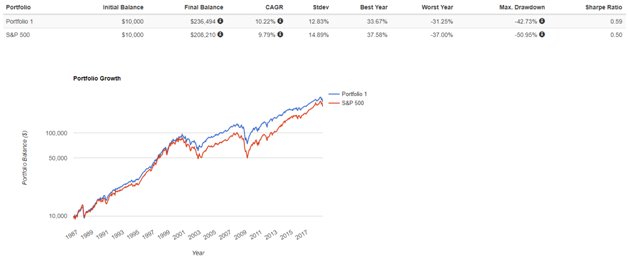
“The CBOE S&P 500 30-Delta BuyWrite Index is designed to track the performance of a hypothetical covered call strategy that holds a long position indexed to the S&P 500 Index and sells a monthly out-of-the-money (OTM) S&P 500 Index (SPX) call option. The call option written is the strike nearest to the 30 Delta at 10:00 a.m. CT on the Roll Date.The BXMD Index rolls on a monthly basis, typically every third Friday of the month.”
Historical index data is available since July 1986 to compare the performance of BXMD to the S&P 500 Total Return Index. The below chart created at www.portfoliovisualizer.com highlights the summary statistics and equity curve with portfolio 1 representing BXMD.

Past performance doesn’t guarantee future results. You cannot invest directly in an index.
From July 1986 – December 2018, BXMD outperformed the S&P 500 by 0.43% per year. Since the only difference is the short call, this tells us that selling a 30-day call every month has been a profitable trade over time. Since a short call is negatively correlated to the underlying index, it results in a slight reduction in portfolio risk where standard deviation, worst year, and maximum drawdown are all reduced. Alternatively, in months where the S&P 500 increases by more than expected, the short calls lose money and BXMD underperforms.
Overall, I prefer to think of put options as financial insurance and call options as lottery tickets. In both instances, it’s rational to expect sellers to profit over time (but not every time). As a covered call seller, you retain almost all of the downside, yet cap your upside. In a world of generally efficient markets, why would any rational market participant do this without the long-term expectation of profit? This theory matches the empirical data.
Additional recommended reading on covered calls:
Jesse Blom is a licensed investment advisor and Vice President of Lorintine Capital, LP. He provides investment advice to clients all over the United States and around the world. Jesse has been in financial services since 2008 and is a CERTIFIED FINANCIAL PLANNER™ professional. Working with a CFP® professional represents the highest standard of financial planning advice. Jesse has a Bachelor of Science in Finance from Oral Roberts University. Jesse manages the Steady Momentum service, and regularly incorporates options into client portfolios.



There are no comments to display.
Join the conversation
You can post now and register later. If you have an account, sign in now to post with your account.
Note: Your post will require moderator approval before it will be visible.